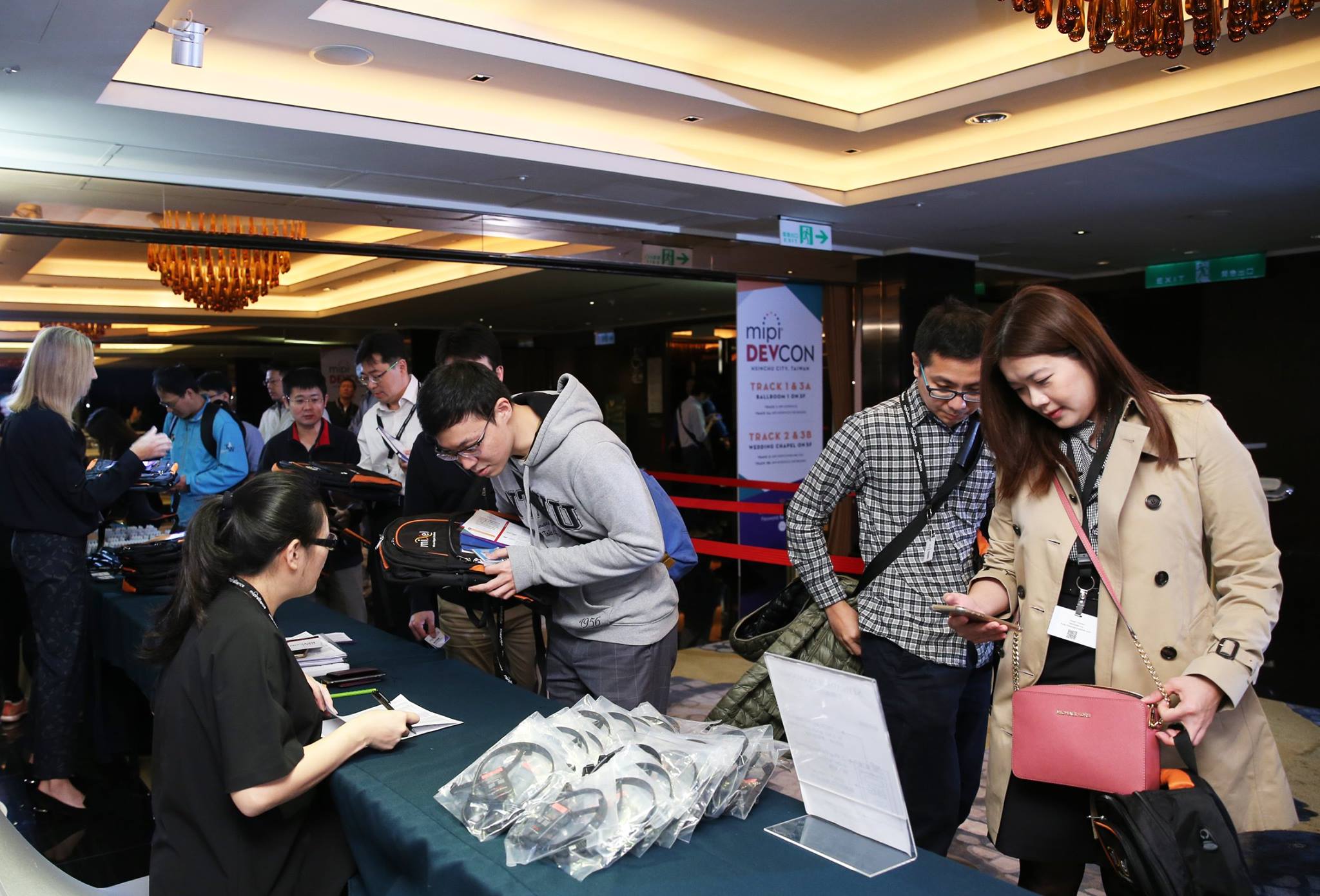2020
Mobile & Beyond

Agenda
Click on the sessions and demos below to view the content.
22 September
-
07:00 to 07:05 | Welcome Day 1
 Justin Endo, chair of the MIPI DevCon Steering Committee, kicks off the day with a welcome to participants and an overview of the agenda for the two-day virtual event.
Justin Endo, chair of the MIPI DevCon Steering Committee, kicks off the day with a welcome to participants and an overview of the agenda for the two-day virtual event.Presenter:
Justin Endo, Mixel's marketing manager, oversees marketing strategy and customer engagement from Mixel's headquarters in San Jose, Calif. In this role, he manages Mixel’s exhibition presence at industry events, the development of press releases and white papers, and the promotion of Mixel’s mixed-signal IP portfolio in various industry media. In addition, he serves as chair of the MIPI Alliance DevCon Steering Committee. He holds a bachelor’s degree with a double major in economics and French from the University of California, Los Angeles, and an MBA from The University of Melbourne – Melbourne Business School.
-
06:57 to 07:17 | Keynote: Trends in Future In-Vehicle Communication Networks
Download the presentation »
View the webcast on demand »

In the coming years, there will be a transition of automobiles to cloud-connected devices with vehicle-centralized E/E-architectures that utilize high-performance server computers. Functions can then be repartitioned between embedded / zonal controllers, server computers and the cloud. Consequently, the communication data volume in the vehicle and to the cloud will increase with a tightening demand for higher bandwidth, lower latency, better determinism and overall improved QoS. As a result, the technology solution portfolio will extend, giving room to high-speed asymmetric links from camera, radar and lidar modules to ECUs and ECUs to displays that transport mobile protocols such as CSI-2 and DSI-2, as well as high-speed Ethernet connecting ECUs, and the evolution of existing technologies such as CAN(-XL), all to meet cost performance demands for the data transmission of video, radar and lidar information.
Presenter:
After earning a Ph.D. in solid state physics (MPI für Strömungsforschung, Göttingen, Germany), Andreas joined the sensor development center of Robert Bosch GmbH in Reutlingen. He has held several positions in sensor development, electronics manufacturing and ECU development, and hejoined a JV with Hyundai Motors in Korea as head of the KEFICO Engineering & Technology Institute (KETI) for engine management ECUs.
From 2011 until 2015, Andreas was responsible for innovation and technology management at the Automotive Electronics division, where he built up an innovation lab and introduced a technology management framework. In 2016, he joined a corporate technology department as head of Systems Engineering for E/E architectures and took over his current position as head of development for E/E architecture and Software Excellence at powertrains solutions by the end of 2018.
-
07:17 to 07:32 | State of the Alliance
Download the presentation »
View the webcast on demand »

MIPI Managing Director Peter Lefkin will present an overview of progress on priority initiatives in mobile and in the beyond-mobile focus areas of automotive, IoT and 5G. The presentation will highlight new MIPI specifications and key specifications in development, along with the Alliance's latest technical, marketing and outreach activities to support specification adoption and enablement.
Presenter:
Peter Lefkin has been providing leadership and guidance to the standards development community for more than 20 years. Since 2011, he has served as the managing director of MIPI Alliance, responsible for all MIPI activities and operations, from strategy development to implementation. As MIPI's senior staff executive, he also serves as secretary on the MIPI Alliance Board of Directors.
Peter's background includes previous leadership roles at the American National Standards Institute, Motorola and the IEEE Standards Association. As COO/CFO for IEEE Industry Standards and Technology Organization (IEEE-ISTO), he was instrumental in the formation of multiple standards groups, including the founding of MIPI Alliance in 2003.
-
07:32 to 07:42 | Demo: Synopsys, Inc.
View the demo on demand »
This demo features Synopsys’ silicon-proven DesignWare MIPI C-PHY/D-PHY℠ IP and DesignWare MIPI CSI-2℠ Controller IP, interoperating with a 64MP image sensor at 24 Gbps.
-
07:42 to 08:12 | MIPI A-PHY: Laying the Groundwork for MIPI’s Automotive SerDes Solutions
Download the presentation »
View the webcast on demand »

As the automotive industry evolves to incorporate advancements in driver assistance, self-driving systems, IVI and other surround-sensor applications, automakers require new solutions that are scalable, interoperable and non-proprietary to meet a broad spectrum of speed and design needs. MIPI Automotive SerDes Solutions (MASS) currently under development are designed to simplify integration by combining Display, Camera and MIPI A-PHY℠ into an end-to-end system offering both security and functional safety. Serving as the foundation of the system, the new MIPI A-PHY specification has the ability to span an entire vehicle (up to 15m) at high speeds and support

native connections to MIPI CSI-2® and DSI-2℠, as well as third-party protocols, such as VESA’s Embedded DisplayPort and DisplayPort.
This presentation will offer an overview of MASS and its related specifications, with a focus on MIPI A-PHY – its structure and topology, reliability and noise immunity levels, and its fit with t other existing networking technologies.
Presenters:
Ariel Lasry has held a Board seat for MIPI Alliance since June 2012. Ariel is actively engaged with standardization activities and contributes to several MIPI Alliance working groups.
Since 1996, Ariel has worked at Toshiba Electronics Europe and has held multiple positions during his tenure. He currently is the chief engineer at Toshiba Electronics Europe where he is responsible for strategic business planning, convergence solutions and technical marketing. He has extensive
experience in strategic marketing, product management, business development and industry alliances. He is well-versed in technical leadership and deployment of new technologies, not only across various business divisions of Toshiba, but also in the industry by stimulating industry alliances and partnerships to create an ecosystem for the successful deployment of new technologies. Prior to his existing role at Toshiba, Ariel worked as a SoC design engineer within the company. He also worked as an engineer at SGS-Thomson Microelectronics Grenoble (now STMicroelectronics).
Ariel is a graduate of Ecole Supérieure D'Electricité (SUPELEC) in Paris & Rennes.
Edo Cohen is the vice-chair of the MIPI A-PHY subgroup and an active member of the MIPI Technical Steering Group. Edo has been a member of MIPI Alliance since 2009, contributing in multiple working groups and previously serving as the vice chair and chair for the Display Working Group.
Edo is Valens’ director for strategic innovation, spearheading automotive standardization. He brings more than 20 years of experience as a senior system engineer, with extensive knowledge in system architecture, technical specifications, definition and execution. Prior to Valens, Edo was a senior system architect at Intel Corporation, heading activities in the wearables and IOT group. Previously, he was a senior staff system engineer at Marvell Cellular Division, responsible for the company’s cellular processor environment and held engineering managerial positions at Floware, Alvarion and NAMS.
Edo holds an MBA and a bachelor of science in electrical engineering from Tel Aviv University.
-
08:12 to 08:22 | Demo: Tektronix, Inc.
View the demo on demand »
Tektronix, Inc. will demo the new MIPI D-PHY℠ TX 2.1 TekExpress® automation solution support on both MSO 6 Series and DPO70KDx\Sx platforms. The application features performance improvement on overall test execution time, with extraordinary user experience, as well as 100% test coverage for MIPI D-PHY TX Spec 2.1 CTS1.0 with up to 4.5Gbps data rate support, including eye diagram measurements and configurable test report, test result statistics and display of first region analysis.
-
08:22 to 08:52 | High Speed MIPI CSI-2 Interface Meeting Automotive ASIL-B
Download the presentation »
View the webcast on demand »

This presentation will cover the deployment of MIPI D-PHY℠ in an autonomous driving use-case and the advantages of using MIPI specifications in functional safety applications.
While all automotive system-on-chip (SoC) designs must meet additional safety requirements, Advanced Driver Assistance Systems
(ADAS) and autonomous driving have even more stringent standards requirements. This presentation will cover Renesas’s high level system design, how Mixel was able to meet

Renesas's requirements with its MIPI D-PHY CSI-2® TX+ IP, and how advanced testability features are critical capabilities for this application. In addition, it will include some of the unique challenges when incorporating mixed-signal IP as Safety Elements out of Context (SEooC) compliant to ISO 26262 and ASIL-B.
Presenters:
Ahmed Ella has been working since 2011 for Mixel, where he heads the company's engineering team in Egypt. Previously, he worked at ICpedia and Mentor IP division, managing teams working on serial link products such as HDMI, USB, and multi standard SerDes. Ahmed has 20 years of mixed-signal design and management experience. He holds a BSEE from Ain Shams University and MSEE from Cairo University in Egypt.
Serge Di Matteo has been working since 2019 for Renesas, where he is part of the automotive business unit management staff in Italy. Previously, he worked at ENEA, Selenia, Accent, WAGO, ZMDI and IDT, managing teams working on radar systems for civil and military applications, industrial and automotive functional safety applications on both systems, and integrated circuits. Serge has 37 years of experience on digital and mixed signal design and management. He holds the degree of electronic engineer at the university “La Sapienza” in Rome.
-
08:52 to 09:02 | Demo: Mixel, Inc.
View the demo on demand »
Mixel, Inc. will be demonstrating its MIPI D-PHY℠ IP integrated into an imaging chip from Microsoft with the world’s smallest time-of-flight pixel. This imaging chip is a key part of the depth camera used in two Microsoft products including a mixed-reality headset that is in mass production.
-
09:02 to 09:32 | MASS: Automotive Displays Using VDC-M Visually Lossless Compression
Download the presentation »
View the presentation with deep dive notes »
View the webcast on demand »

Automotive 5G connectivity, wireless updates, electrification, autonomy and vehicle sharing are five new automotive trends driving an increase in automotive display resolution, size, contrast and quantity per vehicle. Next generation automotive display architectures must prepare for multiple displays with 4K to 8K resolution designed to support content and features enabled by the powerful trends, and automotive OEMs must meet these new requirements within tight cost, weight and 5G RF interference constraints. This presentation illustrates a state-of-the-art MASS (MIPI Automotive SerDes Solutions) display architecture that leverages the latest MIPI DSI-2℠ protocols using VDC-M visually lossless compression algorithms to optimize pixel bandwidth within tightly constrained display systems.
Presenter:
James Goel has a bachelor’s of applied science (B.A.Sc) in electrical engineering from the University of Waterloo in Canada and is a licensed professional engineer (P. Eng.) in Ontario where he's practiced for the last 30 years. He's spent his career developing designs and technical standards for artificial intelligence/machine learning, video, audio and interface solutions in both engineering and management positions. He's been with Qualcomm for the last nine years after it acquired his previous company.
-
09:32 to 09:42 | Demo: Teledyne LeCroy
View the demo on demand »
Teledyne LeCroy will demonstrate the Envision X84 CSI-2℠/DSI-2℠ Protocol Analyzer and Generator. The demonstration will focus on how the Protocol Analyzer can be used with automotive SerDes. This demo will also highlight the ease with which users can generate MIPI CSI-2 to generate packet sequences or play full frame images.
-
09:42 to 10:12 | How MIPI Interfaces Solve Challenges in ADAS/AD Sensor Validation
Download the presentation »
View the webcast on demand »

One of the greatest challenges in making autonomous driving (AD) a reality is validation and testing. Test drives are expensive, giving rise to data-driven development and testing, which involves logging dozens of environment sensors (camera, radar, lidar), data replay in the lab and cloud, and hardware-in-the-loop (HIL) testing.
This presentation addresses how the MIPI CSI-2℠, D-PHY℠, CCS, and A-PHY℠ specifications simplify validation and testing and help bring AD to the streets.
Presenter:
Gregor Sievers, Ph.D., is a manager in the engineering services department at dSPACE GmbH, Paderborn, Germany. His work focuses on the validation of systems for autonomous driving. In 2016, he received his Ph.D. in electrical engineering from Bielefeld University, Germany, for his work on design-space exploration of tightly coupled multiprocessors.
-
10:12 to 10:22 | Demo: Introspect Technology
View the demo on demand »
Introspect Technology, producer of innovative test and measurement equipment, will demonstrate its latest MIPI D-PHY℠ 3.0 and MIPI C-PHY℠ 2.0 receiver test solutions. Building on its award-winning equipment for previous-generation physical layer standards, Introspect Technology will show how easy it is to generate C-PHY patterns at 8 Gsps and D-PHY patterns at 12 Gbps.
-
10:22 to 10:52 | Closing Session: MASS - Is There a Need for a New Automotive SerDes?
View the session on demand »
In recent years, the automotive market has been one of the most active investment areas for the semiconductor industry. With the growth of electric vehicles, and the expansion of assisted and autonomous driving (ADAS and ADS), the number of electronic components in the car has increased dramatically, presenting a host of significant data and integration challenges as well.
In this session, representatives from across the automotive ecosystem will explore how the semiconductor market is addressing the unique challenges that these trends present. Specifically, discussions will include the need for standardized long-reach SerDes solutions that simplify integration and the need to address functional safety and security within these solutions.
Moderator:

Kevin Yee is director of IP and ecosystem marketing at Samsung Foundry, responsible for driving strategic partners for IP enablement and SoC ecosystem.
With more than 25 years in the semiconductor industry, he has served a variety of senior management roles in R&D engineering, product planning, sales, marketing and business development in system, semiconductor, FGPA, IP/VIP and EDA companies. Kevin's background includes system/ASIC design, FPGA architecture, IP development and holds several patents on design architecture. He is actively involved with industry standards organizations such as PCI-SIG, USB I/F, CCIX, CXL, JEDEC and MIPI, driving the latest in industry standards and technologies. He holds a bachelor of science in electrical engineering from the University of California.
Panelists:

After earning a Ph.D. in solid state physics (MPI für Strömungsforschung, Göttingen, Germany), Andreas Lock joined the sensor development center of Robert Bosch GmbH in Reutlingen. He has held several positions in sensor development, electronics manufacturing and ECU development, and he joined a JV with Hyundai Motors in Korea as head of the KEFICO Engineering & Technology Institute (KETI) for engine management ECUs. From 2011 until 2015, Andreas was responsible for innovation and technology management at the Automotive Electronics division, where he built up an innovation lab and introduced a technology management framework. In 2016, he joined a corporate technology department as head of Systems Engineering for E/E architectures and took over his current position as head of development for E/E architecture and Software Excellence at powertrains solutions by the end of 2018.

Hezi Saar is a director of product marketing at Synopsys and is responsible for its Mobile, Automotive and Consumer DesignWare IP product lines. He brings more than 21 years of experience in the semiconductor and electronics industries in embedded systems. Hezi holds a Bachelor of Science degree from Tel Aviv University in computer science and economics and an MBA from Columbia Southern University.

Rick Wietfeldt is a senior director, technology, at Qualcomm Technologies Inc. in San Diego. He joined Qualcomm in 2007 and established the Advanced Connectivity Technology office responsible for the standards developments organizations
(SDO) that drive mobile interface standards. He has authored numerous publications and been awarded numerous patents in mobile device architecture and operation. Prior to joining Qualcomm, Rick worked at Texas Instruments in Dallas from 2003-2007 as the OMAP CTO running the U.S. CTO office and helping position OMAP as the workhorse processor of the early smartphone era. Rick received his bachelor of science and master's degrees in electrical engineering from the University of Toronto, and his doctorate from York University in Toronto.
23 September
-
06:52 to 06:57 | Welcome Day 2

MIPI DevCon Chair Justin Endo will kick off the day with a welcome and overview of the first virtual MIPI DevCon.
As Mixel's marketing manager, Justin Endo oversees marketing strategy and customer engagement from Mixel's headquarters in San Jose, Calif. In this role, he manages Mixel’s exhibition presence at industry events, the development of press releases and white papers, and the promotion of Mixel’s mixed-signal IP portfolio in various industry media. In addition, he serves as chair of the MIPI Alliance DevCon Steering Committee. He holds a bachelor’s degree with a double major in economics and French from the University of California, Los Angeles, and an MBA from The University of Melbourne – Melbourne Business School.
-
06:57 to 07:27 | MIPI Alliance: Enabling the IoT Opportunity
Download the presentation »
View the webcast on demand »

The coming of the "Internet of Things" heralds a huge growth in new services aimed at enhancing our lives through the ever greater coupling of the physical, social and digital worlds. In what will undoubtedly be a highly competitive market, it will be essential for developers to understand the best technology building blocks available to them and make the right technology choices to ensure both technical and commercial success.
With MIPI Alliance’s focus on delivering specifications for mobile devices that enable state-of-the-art embedded electronic designs that are low complexity, low power and highly efficient, MIPI has a wide portfolio of specifications that are highly relevant and beneficial for use within IoT devices.

This presentation will explain the advantages of using MIPI specifications within IoT devices and provide an overview of the MIPI specifications that are most relevant to the IoT market, explaining the use and applicability of each specification within an IoT context. We'll also explore a variety of IoT vertical industries, highlighting how MIPI specifications can enhance the design of many different types of IoT devices within each vertical sector.
Presenters:
Kevin Yee is director of IP and ecosystem marketing at Samsung Foundry, responsible for driving strategic partners for IP enablement and SoC ecosystem. With more than 25 years in the semiconductor industry, he has served a variety of senior management roles in R&D engineering, product planning, sales, marketing and business development in system, semiconductor, FGPA, IP/VIP and EDA companies. Kevin's background includes system/ASIC design, FPGA architecture, IP development and holds several patents on design architecture. He is actively involved with industry standards organizations such as PCI-SIG, USB I/F, CCIX, CXL, JEDEC and MIPI, driving the latest in industry standards and technologies. He holds a bachelor of science in electrical engineering from the University of California.
Based in the UK, Ian Smith presently works as an independent consultant specializing in the Internet of Things, mobile telecommunications and cyber-security. Working at the forefront of mobile technology for over 20 years, Ian has helped numerous global organizations achieve major technology firsts. This includes helping the GSMA develop the first globally recognized set of IoT security guidelines and leading the GSMA’s development of the first standardized Embedded SIM (eSIM) for IoT services. He has also held leading roles within network operators, including Hutchison (Three UK) and Orange, driving the launch of the world’s first 2.5G, 3G and 4G handsets and services. Most recently Ian has been working with MIPI Alliance to deliver an IoT white paper that outlines how MIPI’s specifications help developers achieve key IoT device design goals such as low power consumption, low cost/complexity and long lifecycles. Ian holds a B.Eng. in electronic engineering and computer science from Aston University, UK.
-
07:27 to 07:57 | MIPI to Bluetooth LE: Leveraging Mobile Technology for Wireless IoT Applications
Download the presentation »
View the webcast on demand »
 Smartphone components have been greatly reduced in cost and power due to demand and the result of high volume manufacturing. This has created opportunities for developers to reuse displays, cameras, microphones and mems sensors for mobile influenced markets.
Smartphone components have been greatly reduced in cost and power due to demand and the result of high volume manufacturing. This has created opportunities for developers to reuse displays, cameras, microphones and mems sensors for mobile influenced markets.Meanwhile a growth in wireless IoT is evident as AI assistant accessories such as Google Home and Amazon Alexa become common place in our homes. As emerging markets such as Smart Home further develop, new forms of programmable semiconductor devices promote innovation by leveraging mobile components for other markets.
This presentation will feature use case examples in the wireless IoT space found while helping customers develop new types of solutions with the first SoC FPGA with built in Bluetooth Low Energy (LE) transceiver.
Presenter:
Grant Jennings is the director of international marketing for Gowin Semiconductor, focused on strategic solutions for programmable technologies. He has more than a decade of FPGA systems architecture experience in areas including ASIC prototyping, interfacing, bridging and edge connectivity. Jennings received his electrical engineering degree from Iowa State University and his MBA from Texas A&M University.
-
07:57 to 08:07 | Demo: BitifEye Digital Test Solutions GmbH
View the demo on demand »
BitifEye will demonstrate different MIPI C-PHY℠ 2.0 signals as they can be used for receiver testing. We will cover nominal signal generation as well as impairment addition and calibration, and we’ll also dive deep into the differences between MIPI C-PHY 2.0 and the previous generation, MIPI C-PHY 1.2
-
08:07 to 08:32 | Why an Integrated MIPI C-PHY/D-PHY IP is Essential
Download the presentation »
View the webcast on demand »
 This presentation will describe the key advantages of the latest MIPI C-PHY℠ and D-PHY℠ specifications and how designers are implementing them in multipixel cameras and high-resolution displays targeting mobile, drone and automotive applications. It is essential to enable the fastest channels between image sensors and processors in SoCs for such cameras and displays, so a more integrated solution, where designers have the best of both PHYs, is very appealing. We will illustrate how to implement MIPI C-PHY and D-PHY while also interfacing with MIPI CSI-2℠ and DSI-2℠.
This presentation will describe the key advantages of the latest MIPI C-PHY℠ and D-PHY℠ specifications and how designers are implementing them in multipixel cameras and high-resolution displays targeting mobile, drone and automotive applications. It is essential to enable the fastest channels between image sensors and processors in SoCs for such cameras and displays, so a more integrated solution, where designers have the best of both PHYs, is very appealing. We will illustrate how to implement MIPI C-PHY and D-PHY while also interfacing with MIPI CSI-2℠ and DSI-2℠.Presenter:
Licinio Sousa is currently a staff product marketing manager responsible for DesignWare MIPI IP solutions. Licinio brings more than 18 years of experience in semiconductor, IP and EDA companies, focusing on software and hardware design. He has also held various R&D, field applications, engineering and marketing positions at Synopsys.
-
08:32 to 08:42 | Demo: Protocol Insight, LLC
View the demo on demand »
Protocol Insight, LLC has been shipping UFS 3.x and UniPro® 1.8 protocol analyzers and exercisers running MIPI M-PHY® HS-G4B since 2017. We will be showing UFS 3.1 link traffic generation and analysis with a live UFS3.x device.
-
08:42 to 09:12 | Interoperability Challenges and Solutions for MIPI I3C
Download the presentation »
View the webcast on demand »
 For an evolving sensor protocol like MIPI I3C®, interoperability testing between multiple vendor solutions is critical. To ensure interoperability, multiple approaches should be taken to achieve maximum test coverage.
For an evolving sensor protocol like MIPI I3C®, interoperability testing between multiple vendor solutions is critical. To ensure interoperability, multiple approaches should be taken to achieve maximum test coverage.This presentation will provide a case study of several specific interoperability challenges and solutions in terms of circuit and layout guidelines, protocol implementations and target applications.
Presenter:
Geoffrey Duerden is a senior member of the technical staff at Introspect Technology. Geoffrey received a masters of engineering at McGill University and has been providing applications support for a wide range of emerging MIPI technologies with Introspect since 2012.
-
09:12 to 09:42 | The Story Behind the MIPI I3C HCI Driver for Linux
Download the presentation »
View the webcast on demand »
 The Linux operating system is widely used across the computing landscape. It is therefore natural to plan Linux support when new technology is developed. However, this doesn't come without its set of challenges, both technical and cultural. The MIPI I3C HCI℠ architecture also comes with its own peculiarities and multiple specification revisions. This presentation will cover the work that has been done to date in the context of those challenges, with a quick overview of future development.
The Linux operating system is widely used across the computing landscape. It is therefore natural to plan Linux support when new technology is developed. However, this doesn't come without its set of challenges, both technical and cultural. The MIPI I3C HCI℠ architecture also comes with its own peculiarities and multiple specification revisions. This presentation will cover the work that has been done to date in the context of those challenges, with a quick overview of future development.Presenter:
Nicolas Pitre is a software engineer with 25 years of experience in embedded software and Linux kernel development. He has worked with many semiconductor industry leaders during his tenures at Linaro, Marvell, MontaVista Software and others, with involvement spanning consumer product development to new processor architecture support. Nicolas is currently a senior software developer at BayLibre.
-
09:42 to 09:52 | Demo: Prodigy Technovations Pvt. Ltd
View the demo on demand »
Prodigy Technovations Pvt Ltd. will demonstrate industry leading UFS3.0/3.1 Protocol Analyzer and MIPI I3C®, MIPI RFEE℠, MIPI SPMI℠ Exerciser and Protocol Analyzers. These products' performance and technical features enable debugging and ensure protocol layer compliance to UFS, I3C, RFFE and SPMI specifications.
-
09:52 to 10:22 | Snapshot of MIPI RFFE v3.0 from a System-Architecture Perspective
Download the presentation »
View the webcast on demand »
 Since its release in July 2010, the MIPI RFFE℠ specification has evolved as the de-facto multi-drop bus architecture to control RF Front-End components. Over the past decade, its constant evolution has ensured absolute adherence to real-time performance of the RF-Front-End in terms of the critical control timing budget. As the latest cellular technology (5G) takes the RF-Front-End to a whole new level of complexity, the recently released MIPI RFFE v3.0 is geared toward meeting these new challenges.
Since its release in July 2010, the MIPI RFFE℠ specification has evolved as the de-facto multi-drop bus architecture to control RF Front-End components. Over the past decade, its constant evolution has ensured absolute adherence to real-time performance of the RF-Front-End in terms of the critical control timing budget. As the latest cellular technology (5G) takes the RF-Front-End to a whole new level of complexity, the recently released MIPI RFFE v3.0 is geared toward meeting these new challenges.This session presents the new features of MIPI RFFE v3.0 from a system-architecture perspective to help architecture and design engineers understand how the triggering features in the latest version work together to improve performance and to switch quickly among the various bands and band combinations in a 5G system:
-
Timed triggers that allow for tighter, synchronized timing control of multiple carrier aggregation configurations
-
Mappable triggers that enable groups of control functions to be remapped
-
Extended triggers that boost the number of unique triggers available in the RF control system and accommodate increasingly complex radio architectures
Presenter:
Lalan Mishra is currently employed with Qualcomm Inc. as principal engineer, and in his current role, he focuses on conceiving next-generation chipset connectivity architecture involving digital and RF circuits. Active at MIPI since 2012, Lalan chairs and co-chairs the Reduced Input-Output (RIO) and the RFFE workgroups respectively. Lalan has 143 patents (issued) and 187 patents (pending) to his credit. He holds a master’s degree from UCSD with specialization in wireless embedded systems.
-
-
10:22 to 10:52 | Closing Session: The Internet of Things – Transitioning from Hype to Reality
View the session on demand »

The coming of the Internet of Things has been heralded for well over a decade with analysts predicting tens of billions of new connected devices covering a myriad of different use cases in every market imaginable. In this fireside chat, a panel of industry IoT experts will "reality check" the present state of the IoT and discuss how MIPI Alliance can help foster its growth. This session will address key topics, such as the present state and future of the IoT market, the markets that are leading the adoption of IoT solutions, and the impact of COVID-19 on industry forecasts. Also covered will be how and where MIPI specifications are expected to have the greatest impact and an overview of the resources that are currently available for IoT developers.
Moderator:
Based in the UK, Ian Smith presently works as an independent consultant specializing in the Internet of Things, mobile telecommunications and cyber-security. Working at the forefront of mobile technology for over 20 years, Ian has helped numerous global organizations achieve major technology firsts.

This includes helping the GSMA develop the first globally recognized set of IoT security guidelines and leading the GSMA’s development of the first standardized Embedded SIM (eSIM) for IoT services. He has also held leading roles within network operators, including Hutchison (Three UK) and Orange, driving the launch of the world’s first 2.5G, 3G and 4G handsets and services. Most recently Ian has been working with MIPI Alliance to deliver an IoT white paper that outlines how MIPI’s specifications help developers achieve key IoT device design goals such as low power consumption, low cost/complexity and long lifecycles. Ian holds a B.Eng. in electronic engineering and computer science from Aston University, UK.
Panelists:
Yiru Zhong has been a M2M/IoT market veteran since 2008, having created a M2M/IoT research program in her industry analyst career. She has also led consulting engagements in smart utilities, transportation and industry 4.0 opportunities, and managed an IoT platform validation program.

Currently, she is the lead analyst for IoT & Enterprise at GSMA Intelligence, the mobile industry’s leading data and analysis resource. In her role, she writes about the practical aspects of IoT technologies and is especially passionate about expressing security from a positive business value perspective. Most recently, she has contributed to the IoT market revenue sizing activities at GSMA Intelligence, focussing on IoT security, platforms and services.
Michele Scarlatella has been with STMicroelectronics since 2003 and is currently director, technology and system architecture, Microcontroller & ICs Division. He has held several positions at STMicroelectronics in strategic planning, central marketing for secure microcontrollers, and as product and application director for the Smart Card division.
Before joining STMicroelectronics, Michele was co-founder and CTO of E-maze, a networking security start-up company serving several blue-chips companies. He also served for 11 years as Telecom’s product designer and product marketing manager for Telecom equipments and payment terminals. Michele began his career in basic scientific research and academia, working at the Stanford Linear Accelerator Center in Paolo Alto, Calif. Michele holds three patents and has published more than 50 scientific papers. He participates on the Board of Directors for the Trusted Connectivity Alliance (formerly SIMAlliance) and the Smart Payment Association and is a member of the GSMA IoT security program.

Kevin Yee is director of IP and ecosystem marketing at Samsung Foundry, responsible for driving strategic partners for IP enablement and SoC ecosystem. With more than 25 years in the semiconductor industry, he has served a variety of senior management roles in R&D engineering, product planning, sales, marketing and business development in system, semiconductor, FGPA, IP/VIP and EDA companies. Kevin's background includes system/ASIC design, FPGA architecture, IP development and holds several patents on design architecture. He is actively involved with industry standards organizations such as PCI-SIG, USB I/F, CCIX, CXL, JEDEC and MIPI, driving the latest in industry standards and technologies. He holds a bachelor of science in electrical engineering from the University of California.







